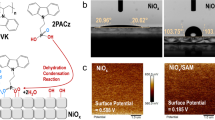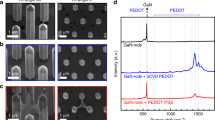Abstract
Achieving balanced electron–hole injection and perfect recombination of the charge carriers is central to the design of efficient polymer light-emitting diodes1,2 (LEDs). A number of approaches have focused on modification of the injection contacts, for example by incorporating an additional conducting-polymer layer at the indium-tin oxide (ITO) anode3,4. Recently, the layer-by-layer polyelectrolyte deposition route has been developed for the fabrication of ultrathin polymer layers5,6. Using this route, we previously incorporated ultrathin (<100 Å) charge-injection interfacial layers in polymer LEDs7. Here we show how molecular-scale engineering of these interlayers to form stepped and graded electronic profiles can lead to remarkably efficient single-layer polymer LEDs. These devices exhibit nearly balanced injection, near-perfect recombination, and greatly reduced pre-turn-on leakage currents. A green-emitting LED comprising a poly(p-phenylene vinylene) derivative sandwiched between a calcium cathode and the modified ITO anode yields an external forward efficiency of 6.0 per cent (estimated internal efficiency, 15–20 per cent) at a luminance of 1,600 candelas per m2 at 5 V.
This is a preview of subscription content, access via your institution
Access options
Subscribe to this journal
Receive 51 print issues and online access
$199.00 per year
only $3.90 per issue
Buy this article
- Purchase on Springer Link
- Instant access to full article PDF
Prices may be subject to local taxes which are calculated during checkout




Similar content being viewed by others
References
Cao, Y., Parker, I. D., Yu, G., Zhang, C. & Heeger, A. J. Improved quantum efficiency for electoluminescence in semiconducting polymers. Nature 397, 414 –417 (1999).
Friend, R. H. et al. Electroluminescence in conjugated polymers. Nature 397, 121–128 ( 1999).
Karg, S., Scott, J. C., Salem, J. R. & Angelopoulos, M. Increased brightness and lifetime of polymer light-emitting diodes with polyaniline anodes. Synth. Met. 80, 111– 117 (1996).
Carter, J. C. et al. Operating stability of light-emitting polymer diodes based on poly(p-phenylene vinylene). Appl. Phys. Lett. 71 , 34–36 (1997).
Decher, G. Fuzzy nanoassemblies: toward layered polymeric multicomposites. Science 277, 1232–1237 ( 1997).
Onitsuka, O., Fou, A. C., Ferreira, M., Hsieh, B. R. & Rubner, M. F. Enhancement of light emitting diodes based on self-assembled heterostructures of poly(p-phenylene vinylene). J. Appl. Phys. 80, 4067–4071 ( 1996).
Ho, P. K. H., Granström, M., Friend, R. H. & Greenham, N. C. Ultrathin self-assembled layers at the ITO interface to control charge injection and electroluminescence efficiency in polymer light-emitting diodes. Adv. Mater. 10, 769–774 (1998).
Tai, K., Yang, L., Wang, Y. H., Wynn, J. D. & Cho, A. Y. Drastic reduction of series resistance in doped semiconductor distributed Bragg reflectors for surface-emitting lasers. Appl. Phys. Lett. 56, 2496–2498 (1990).
Arkhipov, V. I., Emelianova, E. V., Tak, Y. H. & Bässler, H. Charge injection into light-emitting diodes: theory and experiment. J. Appl. Phys. 84, 848–856 (1998).
Yoo, D., Shiratori, S. S. & Rubner, M. F. Controlling bilayer composition and surface wettability of sequentially adsorbed multilayers of weak polyelectrolytes. Macromolecules 31, 4309–4318 (1998).
Lösche, M., Schmitt, J., Decher, G., Bouwman, W. G. & Kjaer, K. Detailed structure of molecularly thin polyelectrolyte multilayer films on solid substrates as revealed by neutron reflectometry. Macromolecules 31, 8893– 8906 (1998).
Dietrich, M., Heinze, J., Heywang, G. & Jonas, F. Electrochemical and spectroscopic characterisation of polyalkylenedioxythiophenes. J. Electroanal. Chem. 369, 87–92 (1994).
Lögdlund, M., Lazzaroni, R., Stafström, S., Salaneck, W. R. & Brédas, J.-L. Direct observation of charge-induced pi-electronic structural changes in a conjugated polymer. Phys. Rev. Lett. 63, 1841–1844 (1989).
Xing, K. Z., Fahlman, M., Chen, X. W., Inganäs, O. & Salaneck, W. R. The electronic structure of poly(3,4-ethylenedioxythiophene) studied by xps and ups. Synth. Met. 89, 161–165 (1997).
van Slyke, S. A., Chen, C. H. & Tang, C. W. Organic electroluminescent devices with improved stability. Appl. Phys. Lett. 69, 2160– 2162 (1996).
Kim, J. S., Friend, R. H. & Cacialli, F. Surface energy and polarity of treated indium-tin-oxide anodes for polymer light-emitting diodes studied by contact-angle measurements. J. Appl. Phys. 86, 2774– 2778 (1999).
Campbell, I. H., Hagler, T. W. & Smith, D. L. Direct measurement of conjugated polymer electronic excitation energies using metal/polymer/metal structures. Phys. Rev. Lett. 76, 1900–1903 (1996).
Brown, T. M. et al. Built-in field electroabsorption spectroscopy of polymer light-emitting diodes incorporating a doped poly(3,4-ethylenedioxythiophene) hole injection layer. Appl. Phys. Lett. 75, 1679– 1681 (1999).
He, Y., Gong, S., Hattori, R. & Kanicki, J. High performance organic polymer light-emitting heterostructure devices. Appl. Phys. Lett. 74, 2265–2267 ( 1999).
Spreitzer, H. et al. Soluble phenyl-substituted PPVs - new materials for highly efficient polymer LEDs. Adv. Mater. 10, 1340–1343 (1998).
Hung, L. S., Tang, C. W. & Mason, M. G. Enhanced electron injection in organic electroluminescence devices using an Al/LiF electrode. Appl. Phys. Lett. 70, 152–154 (1997).
Kim, J. S., Ho, P. K. H., Greenham, N. C. & Friend, R. H. Electroluminescence emission pattern of organic light-emitting diodes: implications for device efficiency calculations. J. Appl. Phys. (in the press).
Harrison, N. T., Hayes, G. R., Phillips, R. T., & Friend, R. H. Singlet intrachain exciton generation and decay in poly(p-phenylenevinylene). Phys. Rev. Lett. 77, 1881– 1884 (1996).
Baldo, M. A., O'Brien, D. F., Thompson, M. E. & Forrest, S. R. Excitonic singlet-triplet ratio in a semiconducting organic thin film. Phys. Rev. B 60, 14422–14428 (1999).
Colthup, N. B., Daly, L. H. & Wiberley, S. E. Introduction to Infrared and Raman Spectroscopy (Academic, New York, 1964).
Acknowledgements
We thank I. Grizzi, D. J. Lacey and E. P. Woo for support; J.-W. Cai for X-ray photoelectron spectroscopy; and A. Gerhard for electroabsorption measurements. P.K.H.H. is on leave from the National University of Singapore and thanks St John's College and IMRE for funding. This work was supported in part by the Engineering and Physical Sciences Research Council.
Author information
Authors and Affiliations
Corresponding author
Rights and permissions
About this article
Cite this article
Ho, P., Kim, JS., Burroughes, J. et al. Molecular-scale interface engineering for polymer light-emitting diodes . Nature 404, 481–484 (2000). https://doi.org/10.1038/35006610
Received:
Accepted:
Issue Date:
DOI: https://doi.org/10.1038/35006610
This article is cited by
-
Formation of hierarchically ordered structures in conductive polymers to enhance the performances of lithium-ion batteries
Nature Energy (2023)
-
Metal oxide charge transfer complex for effective energy band tailoring in multilayer optoelectronics
Nature Communications (2022)
-
Synergistic enhancement in the microelectronic properties of poly-(dioctylfluorene) based Schottky devices by CdSe quantum dots
Scientific Reports (2020)
-
Charge carrier performance of phosphazene-based ionic liquids doped hole transport layer in organic light-emitting diodes
Applied Physics A (2020)
-
Electrochemical synthesis, characterization, and spectroelectrochemical evaluation of poly(para amino benzoic acid-co-4,4-diaminodiphenyl sulfone) film
Journal of Materials Science: Materials in Electronics (2019)
Comments
By submitting a comment you agree to abide by our Terms and Community Guidelines. If you find something abusive or that does not comply with our terms or guidelines please flag it as inappropriate.



